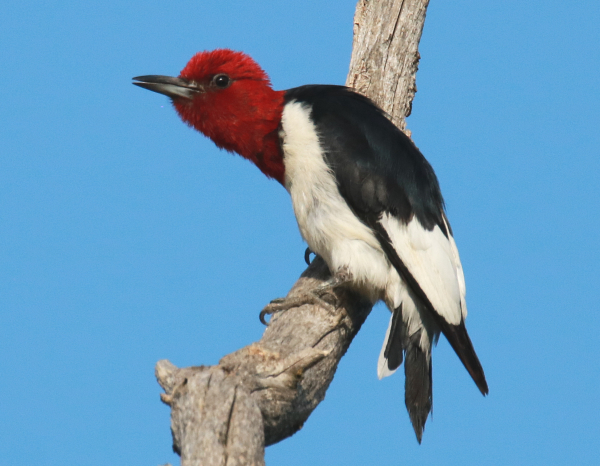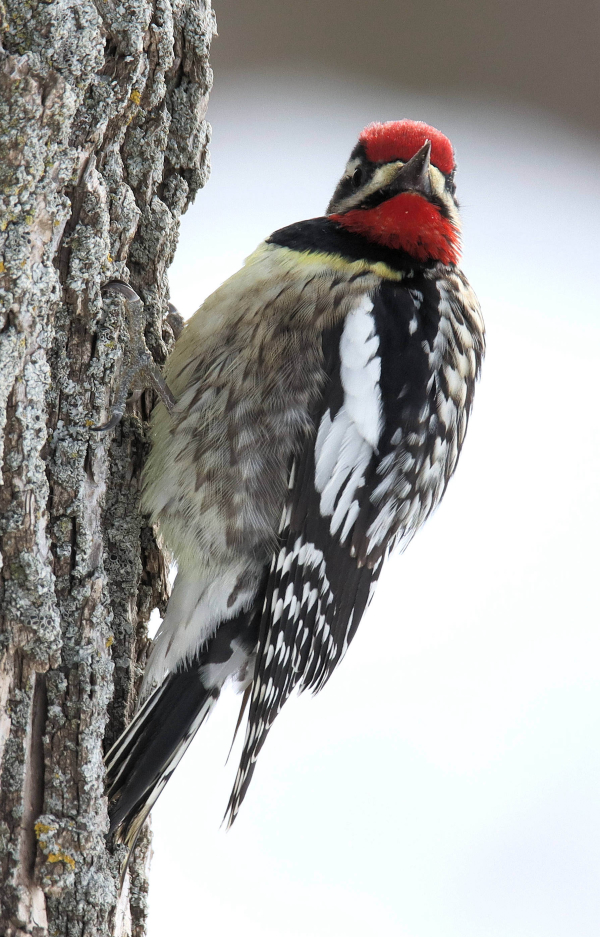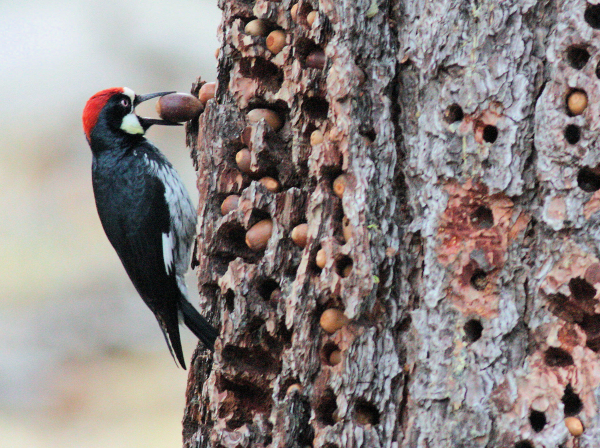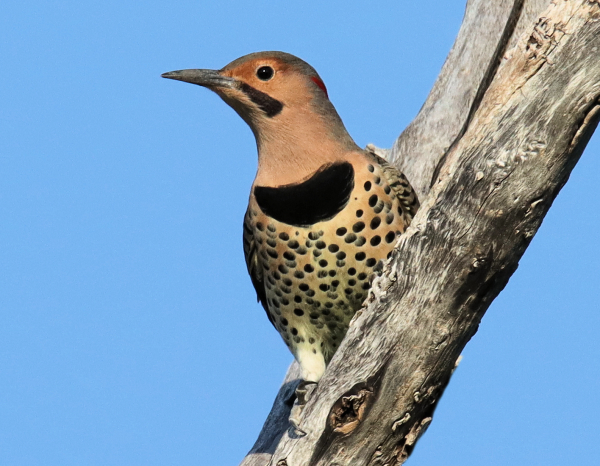Almost anyone can distinguish a woodpecker from other birds. Woodpeckers tend to be associated with trees, where they can find insects and their larvae, and sometimes berries and other small fruits. They also use trees to communicate, tapping or drumming on trees, especially hollow or dead trees with more resonance that amplifies the distance the sound travels. Most important, woodpeckers excavate cavities in trees to use as nesting sites or roosting sites, which also provide nesting cavities for other birds during future years.

Woodpeckers are not easy birds to photograph, so just getting a simple portrait of a woodpecker on a natural perch in beautiful sunlight is a big success, one that should always be celebrated (600mm zoom lens, f-8 aperture, 1/1250 shutter speed, 400 ISO).
For the most part, woodpeckers are fairly wary birds – relatively easy to see from a distance, but not very easy to approach close enough to photograph. Even then, woodpeckers tend to stay on the opposite side of a tree or branch to stay out of sight. In short, trying to photograph woodpeckers can be frustrating. Indeed, although I’ve had chances to photograph woodpeckers in many remote parts of the world, including some very impressive-looking woodpeckers in equatorial Peru, at the southern tip of Argentina, in India, Zambia, Malaysia, and other forested locations, but I have precious few photographs of Asian, African, or Latin American woodpeckers.
Closer to home, I’ve had some good luck with certain species, although it took a lot of persistence over many years. A favorite subject has been Red-headed Woodpeckers, which have been attractive to me since I was very young. But it’s only been during recent years that I’ve had good luck photographing Red-heads, and then it’s been when I found a pair foraging in a nesting territory as they raised nestlings in a nearby cavity.
Before they have nestlings the woodpeckers are less obvious in the open, but when they have a number of hungry growing nestlings to feed, both adults are very active. In the case of Red-headed Woodpeckers in my region, they are seen more often in the open then, in grasslands and fields adjacent to the woods where their nesting cavity was constructed, or should we say excavated.

The chance to take an action photo, showing more character that adds to a portrait you have already taken is always a big plus. This image stands among Paul’s favorite woodpecker photographs, taken when the Red-headed Woodpecker became very animated, bobbing up and down while calling (600mm zoom lens, f-8 aperture, 1/1250 shutter speed, 400 ISO).
My best luck has been photographing the woodpeckers when they perch at a tree or pole where they watched for large insects near their nest site. When you observe woodpeckers on territory, you soon learn they have preferred perches where they watch for big bugs and fly to the ground to grab one. They may also catch large flying insects on the wing, then take the catch to the nesting cavity to feed growing nestlings. After a minute or so, the adults tend to return to their preferred perch and repeat the hunt and delivery process.
My best woodpecker photo opportunities have come when a woodpecker is trusting enough to permit me to park my mobile photo blind (my vehicle) near the perch it uses most often when hunting for large insects. But there are a couple other things that enter into the choice of positioning – where to park and when to photograph. To get the best photos of any birds, photos that replicate the true colors, the brightest most natural colors, you need direct sunlight. That means positioning yourself between the sun and the woodpecker, with the sun directly behind you and the woodpecker in front of your position.

Taken at an elm tree adjacent to Paul’s feeding station, this head-on image of a Yellow-bellied Sapsucker was taken while the new yard bird created a number of small sap wells during early spring (550mm zoom lens, f-7 aperture, 1/500 shutter speed, 400 ISO).
|
The optimum sunlight angle is an important consideration too. That’s when the sun is between 60 and 20 degrees above the horizon behind you (with 90 degrees being directly overhead and the horizon being 0 degrees). That will limit your prime photo time to mid-morning and late afternoon during summer, although when the sun is low in the southern sky during winter months, you can photograph almost any time of day the sun is shining.
The angle of the sun may sound tricky at first, but it’s an easy calculation, and a very important one to get the best colors and eliminate shadows on the bird. I watch the belly and sides of the bird to judge whether shadows are a factor, and reposition to try to eliminate shadows as much as possible. Shadows that may not be very obvious in the field tend to show much darker on your photographs. All that being said, as when photographing any birds, I limit my photo periods to when there is clear sunlight, during periods when the sun is at the best angles.
On the Fly
Of course, I take advantage of any and all opportunities to photograph woodpeckers during my regular birding drives and walks on sunny days, but as noted above, woodpeckers are hard to approach away from foraging perches in their nesting territory. The species I’ve had the most luck photographing away from a nesting territory has been Northern Flickers, especially during fall when flickers can be found in small flocks, feeding on ants in open lawns and parks. Similar-looking and closely related to flickers, Gila Woodpeckers have provided good photo ops in the Sonoran Desert – primarily in the southern half of Arizona where they are most commonly associated with saguaro cacti “forests.” Gilas even excavate nesting and roosting cavities in the tall, multi-armed saguaro cacti.

To photograph this Acorn Woodpecker at its granary in a low light position, the aperture and shutter speed settings were reduced to low levels while the ISO was increased from 400 to 1600 (400mm telephoto lens, f-5 aperture, 1/160 shutter speed, 1600 ISO).
Another species I’ve had pretty good luck photographing has been Acorn Woodpeckers, which I have most often encountered in the mountains of southern California. There the social Acorn Woodpeckers can be seen in extended family groups near nesting cavities, and even more often at their acorn “granaries” where they excavate a small hole where they to store each acorn, all positioned about an inch apart in the trunk of a tree, often a large pine tree. Acorn Woodpeckers are usually quite trusting near their granary, and if you can position nearby without affecting the behavior of the birds, you should get some nice photo ops as long as you have good sunlight.
Photographing sapsuckers at a sap well can provide a similar photo situation to photographing adjacent to a granary – it’s mostly a matter of making sure you have the sunlight in your favor. And in all woodpecker photo cases, make sure the birds aren’t affected by your presence or position, especially when they are near a food source, or a nest site – the birds always come first!

Often seen foraging for ants on the ground, this portrait of a male Northern Flicker is a fine starting point for trying to elevate to taking a series of photos showing more activities of this widespread woodpecker species (600mm zoom lens, f-8 aperture, 1/1000 shutter speed, 400 ISO.)
The technical side of woodpecker photography is very simple: If you want a deep area in focus, use the higher numbered aperture settings from f-10 to f-14. If you want a narrow area in focus, opt for an f-4 or f-6 for example. Shutter speed is less of a factor, unless you’re trying to take flight photos, which are usually best at a shutter speed above 1/1,000.
One thing we haven’t zeroed in on yet with regard to photographing woodpeckers might be the most obvious – you can always photograph at a feeding station that has a suet feeder, and some shelled black oil sunflower seeds. These foods are preferred by many woodpeckers, ranging from Downy Woodpeckers to Pileated Woodpeckers. At a feeding station you can take photos of the woodpeckers perched on the feeders, or for a more natural setting, when they land on an adjacent tree trunk or branch, as they tend to do before and after visiting a feeder. Even so, there is nothing wrong with including a clean, well-stocked feeder in bird photos, but it’s always best to try to make it a pleasing part of the photograph, something that adds to the image.
In fact, you can even set up a special woodpecker feeding station to facilitate getting better photos. At home, or even if you are traveling, it’s easy to set up a suet feeder and seed feeder; then add a natural-looking perch near the feeders for woodpeckers to land on as they approach and leave a feeder. Overall, enjoy woodpeckers whenever you have the chance to see them, and appreciate the chances you get to photograph them. Woodpeckers are certainly an interesting family of birds and a challenging group to photograph – Good Luck!
Article and Photographs by Paul Konrad
Share your bird photos and birding experiences at editorstbw2@gmail.com